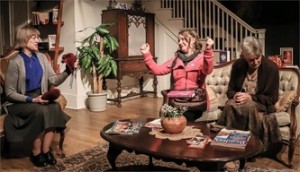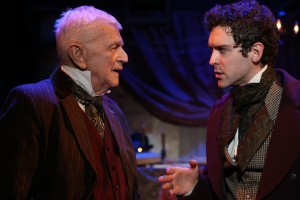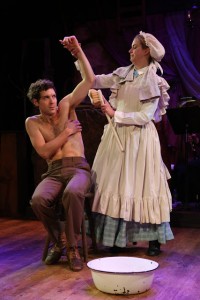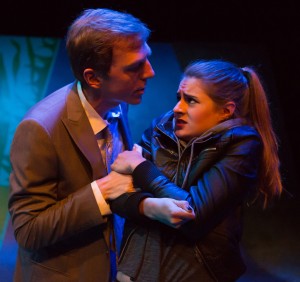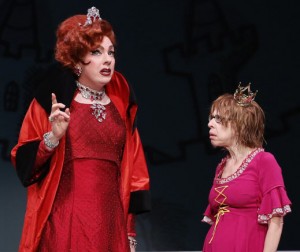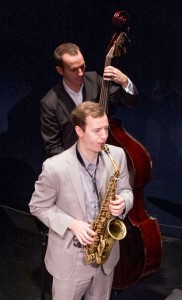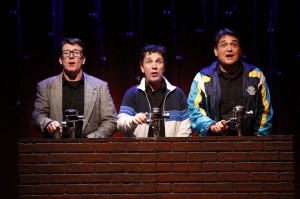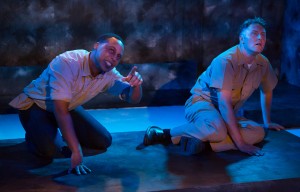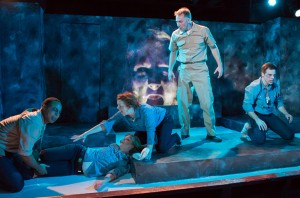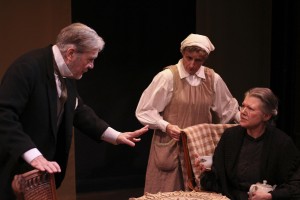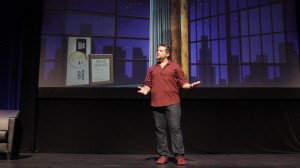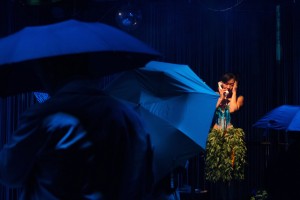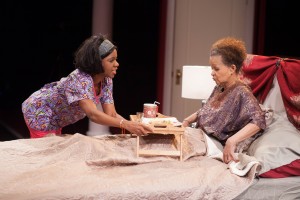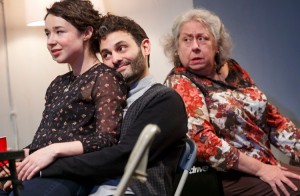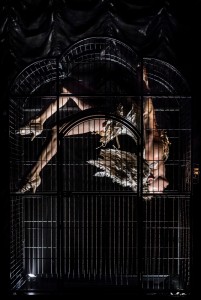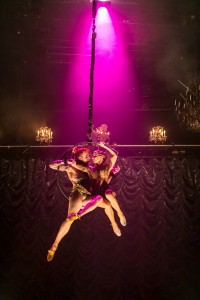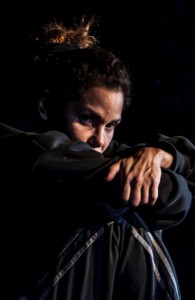According to Flannery O’Connor, “the basis of art is truth, both in matter and in mode.” And the truth is in the pudding in the revival of The Savannah Disputation, a charming and thought-provoking comedy by Evan Smith produced by Me & She Productions and ManyTracks Inc., at The Cell Theatre, the beautiful artists’ rental space in Chelsea. Set at Christmas time in Georgia, it is an exploration at the battle between the righteous. It’s the Catholics versus the Protestants in Southern style.
Two unmarried prudish Catholic sisters, appropriately named Mary and Margaret (played by Lucy McMichael and Charlotte Hampden respectively) are forced to defend their faith to Melissa (played by Katie Yamulla), an overzealous Protestant cheerleader for Jesus. The situation becomes tricky when they call in the troops, Father Murphy and their parish priest (performed by Michael Gnat) to prove his valor and set the wayward Protestant straight. They all learn some humbling lessons as they try to prove that their idea of faith is right and the other is wrong. Of course, they all learn that maybe they are really on the same side after all and that maybe organized religion isn’t always the best way to save your soul.
Understanding the details of time and place is necessary to an accurate and convincing set. Sarah Edkins was spot-on with her interpretation of an old-style Southern Catholic home in Georgia. Complete with Better Homes and Gardens and Reader’s Digest on the mahogany coffee table that anyone from the South would recognize—the only missing magazine was Southern Living.
The two sisters are like the good fairies in "Sleeping Beauty" trying to figure out which color Princess Aurora’s dress should be. Both bicker and flit around their pristine cage showing their contrasting temperaments. But Melissa, the enthusiastic holy roller, is no princess. In tight leggings, hot pink valor and flip flops, Yamulla throws on all the Southern charm to sell them on Jesus. Father Murphy is the voice of reason, who in between bites of banana pudding, enlightens them all to certain decrees of Catholicism, forcing the sisters and Melissa to question their own misinterpretations of religious dogmas.
As typical with sisters, one is sweet and unsure; the other is aggressive and hot-tempered. They are true Southern ladies of biblical proportions. While Mary is ready to barricade the fort against the forces of evil that Melissa seems to represent (Protestant white trash), Margaret is much more open to listening to Melissa’s perspective. Demanding that Father Murphy set things straight, Mary is mortified when she learns that the Catholic faith also believes that earthly bodies will rise and go to Heaven—one of the many tenants that Melissa is preaching which Mary is convinced is a lie: “You Christian Delinquent!” This sets her off in a fury to denounce herself from the Catholic faith; she rails in her denial for excommunication which Father Murphy explains to her one cannot do to themselves.
Both actresses are defenders of the faith with a scent of lavender and hot sauce. Director Katrin Hilbe gives leeway for her actors to explore the emotional life of their characters with the rich dialogue created by Smith. Mary defends herself righteously with lines such as “That is the way the Lord made it’s not my fault.” Margaret, bothered and bewildered by the contractions Melissa offers: “I just want to be buried next to somebody I know.” Sweet Melissa justifies her need to convert her wayward hostesses with retorts like “Catholics are just people too when you take away their religion.” Her phone goes off randomly at perfect times in the action with the "Mission: Impossible" theme song ringtone, enhancing the dilemma she faces trying to help guide her new friends to the true way to Jesus.
The Cell Theatre is a cozy performance space that invites the audience into a realistic home environment. The set encompassed the entire space besides the round seating for the audience. A grand piano with family portraits, a Faulknerian settee, doorways off to a kitchen and backyard, and wooden cabinets full of unopened Scotch all create the mood of old school Catholic Georgia. The use of the stairway and upper floor as part of the action was also very effective. When Mary preaches down to the others in her dismay and denunciation of Catholicism, the contrast of the giant mural of El Greco's "Christ Carrying the Cross" on the stairway wall further enhances the play's themes.
After the ammo smoke settles, they all are left shell-shocked with doubts about their religion, while also realizing they have been stripped bare of the canonical veil and are left eating their own humble pie. Through Hilbe’s direction and the ensemble of designers and actors, we see a clear picture of the battle for faith in us all. While letting us laugh at a very deep issue of the dangers of dogmatic religious beliefs, Hilbe's interpretation of Smith's masterpiece leaves us all reflecting on our own belief systems and eating a bit of humble pie, too.
The Savannah Disputation is running until Dec. 20 at Nancy Manocherian's Cell Theatre (338 West 23rd St. between 8th and 9th Aves.) in Manhattan. Tickets are $18 and can be purchased by calling OvationTix at 212-352-3101 or visiting https://web.ovationtix.com/trs/pr/952841 or www.meandsheproductions.org.






